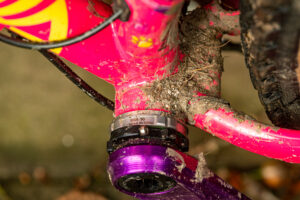Electronic shifting has reached the trails and, despite some teething issues, Shimano has a winner
Shimano XTR Di2 review
Need to Know
- Wired electronic 11-speed drivetrain
- Synchro Shift allows you to run multiple chainrings from one shifter
- A single battery charge should last around six months
- Shiomano XTR Di2 M9050 kit constitutes an electronic front and rear derailleur, a pair of Firebolt shifters, a handlebar-mounted display, a battery module, an E-tube wiring kit and a battery charger/computer interface to aid customisation
When Shimano launched electronic shifting for road bikes, it was inevitable that we’d eventually see the technology transfer to mountain biking. It’s been a long wait, but Di2 is now an option on Shimano’s top-end XTR groupset.

Cockpit head unit flags up gear and program choice
Although motors and electronic signals have replaced traditional steel cables, Shimano XTR Di2 still offers you the option to configure your drivetrain with either a single, double or triple chainset.
If you want to run multiple chainrings, but prefer the uncluttered approach of using a single shifter, Shimano offers something called Synchro Shift. This lets you run two mechs from the right-hand shifter, and boasts an auto-shift function, whereby the system automatically selects the next gear, regardless of chain position.
Fitting Di2 is straightforward, but I had a few issues trying to accommodate the E-Tube wires and the junction box. On my Vitus Escarpe test bike, I’ve hidden most of the wiring under the plastic down tube guard, and I’m also running a Di2-compatible Pro Tharsis stem and handlebar, which means I’ve been able to hide the battery in the steerer tube.

Synchro shift: one shifter activates both derailleurs
Once installed, you plug the system into a PC for an initial set-up. This lets you configure how the gear levers (shift switches) function, including selecting which switch controls the upshift and which the downshift. There’s also different gearing maps to pick from, allowing you to specify at what point the front derailleur shifts between the inner and outer rings.
By pressing the small button on the display, you can toggle between two maps (S1 and S2), and a manual option, while riding. With so many options to choose from, finding my optimum set-up took some trial and error.
Watch: How to replace your Shimano external, threaded bottom bracket
Initially, I used a map where the chain stayed in the outer ring until the rear derailleur reached the biggest sprocket. Apparently, this is favoured by most XC pros but, since I don’t race, I opted to have the front mech shift earlier. This meant I could get into my rhythm sooner when climbing, but the shift did steal a little bit of momentum.

Front derailleur can be programmed with various shifting modes
Equally, I also found myself waiting for the chain to move back across to the outer ring when starting a descent. Another obvious difference with Shimano XTR Di2 is that the shift switch positions don’t mimic those of a manual system.
They sit slightly differently under the hand. I actually reversed the shifter function, because I preferred using the lower switch for changing up. I also ran the shift speed at its fastest setting; there are six to choose from. I’ve got a lot more experimenting to do with the gear maps, but in terms of shift performance, Shimano XTR Di2 feels surprisingly similar to mechanical.
Shifting speed is the same, so I haven’t had to change the way I ride. Di2 has been around on the road since 2009. Even so, there are a couple of things that I think could be improved off-road.

Rear derailleur’s wiring is a potential weak spot
The set-up software needs to be Mac compatible, or better still, accessible via a smartphone. The wires need some sort of reinforcement, especially at the rear derailleur, and the junction box also needs better integration. Hiding the battery in the steerer tube is a great idea, but it does mean you have to use a specific stem.
Hopefully some of these issues will be sorted when Di2 eventually trickles down to the more affordable XT level, and more bike manufacturers configure their frames for the Di2 hardware.
Right now, electronic gearing may seem like an expensive toy, but providing it can be delivered at a more affordable level, many more riders will be able to enjoy the improvements that it brings to efficiency and reliability.
















